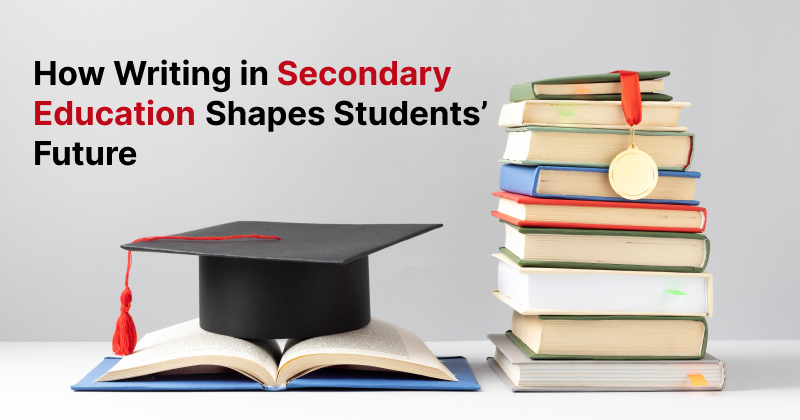Writing is the foundation of the human connection and way of communication. Writing is important in secondary education because it allows students to express their ideas, thoughts, and emotions to others. Writing has become one of the most important skills in secondary education, shaping students’ abilities in academics and beyond. Nowadays, schools emphasize writing not only as a subject but also as an essential tool for student success. But what is the importance of writing in secondary education?
With the rise of digital communication, the value of writing also increased. Whether writing emails, reports, or social media posts, writing influences how we communicate with others. Good writing skills build confidence, critical thinking, and confidence. It helps us to solve problems, communicate clearly, and be successful in our careers. Educational institutions are also focusing on improving writing skills for both exams and professional challenges.
What Is Secondary Education?
Secondary education refers to classes 6 to 12 for students aged 12 to 18 years. The exact age can vary from school to school. It focuses on the advanced knowledge of subjects like science, languages, social studies, and mathematics. The secondary education definition says it’s a stage of building important skills such as critical thinking, problem solving, and communication, preparing students for further studies and higher education. Many schools celebrate their students’ graduation with high-quality Custom Diploma Covers to prepare them for the next phase of life.
Secondary Key Stages Curriculum Overview
The curriculum of secondary education is divided into two stages, such as the first, which is key stage 3 for ages between 11 and 14, and the second, which is key stage 4 for the age group 14-16. In key stage 3, students focus on the study of core subjects like science, English, art, mathematics, history, art language, and physical education. The main aim for this curriculum is to prepare students for the examination and further education.
How Secondary Education Use Writing to Prepare Students?
Schools and colleges in secondary education use writing to build students’ communication, critical thinking, and ability to solve complex problems. They integrate the writing curriculum across all subjects, helping students to express complex ideas and organize their thoughts. Regular writing practice develops strong memory retention and vocabulary and improves reading skills.
Writing Skills Developed In Secondary Education
In secondary education, writing skills are developed in many ways, from essay writing practice to creative writing challenges. Students learn different types of writing skills in secondary education.
Academic Writing:
In academic writing, students learn how to organize their thoughts clearly, use grammar, write easily, and research papers. Students learn sentence formation, placing the right articles and prepositions, and building strong thinking skills.
Creative and Analytical Writing
Creative and analytical writing support to visualize things and a clear understanding of the topics. Writing helps students to express themselves clearly, share thoughts, and improve both written and spoken communication.
Communication and Expression
As we discussed, writing can help you build strong communication skills and express your ideas and thoughts. These skills are important for school, college, and the workplace. Overall, secondary-level education means preparing students for strong writing ability that supports their academic growth and communication.
Importance of Writing In Secondary Education
Writing skills play an important role in a student’s life, whether you are from school or college. In higher education, strong writing skills are required for communicating the ideas, views, and thoughts in research papers and projects. Also, good writing skills prepare students for postsecondary education and professional careers.
What Is Postsecondary Education?
Postsecondary education is the study of various subjects after graduating from high school. It can take place at a college, university, diploma course, or skill development institution. It is important because it helps students gain advanced knowledge and skills for the next phase of academics and careers. Many students obtain diplomas, certificates, and degrees in this phase, which improves their chance of getting better job opportunities. For students graduating from secondary school with a quality leather diploma cover, it symbolizes that they are ready for postsecondary education.
Role of Writing In Postsecondary Education
Writing plays an important role in higher education success, for example, problem solving, critical thinking, and personality development. Developing strong writing skills helps students communicate professionally, which helps them in their careers and professional lives.
Career Readiness:
Career readiness refers to the skills and knowledge to succeed in the workplace. It also includes teamwork, digital writing, and the ability to learn fast. Nowadays, employers want graduates able to communicate clearly and adapt to their work environment fast.
Problem Solving and Critical Thinking:
It is important to develop a strategy to support solutions and values for critical thinking and problem-solving, which involves careful analysis of situations, creativity, and critical decision-making. In higher education, students are often driven by evidence, engagement with perspectives, and exploring means to arrive at a solution.
Personal and Professional Development:
Personal and professional development are two concepts that refer to the never-ending pursuit of self-growth or coworker growth. Writing, collaborating, and learning new skills contribute to a positive process of development. Writing strongly means clearly expressing an idea; collaborating means being adaptable in a solution or situation with others.
Secondary-Level Writing Challenges and Their Solutions
Grammar errors, sentence formation, thought organization, and effective communication are all common secondary-level writing challenges. Students often struggle with writing and developing strong written skills, which has an impact on their performance. To solve these problems, the following important factors should be considered:
Effective Teaching Methods: The right teaching methods can help students improve their writing skills. Examples include breaking down tasks into smaller steps, group discussions, and examples. Teachers can use creative methods and simple topics to help students develop skills in an easy way.
Essential Tools for Improvement: Writing skills can be improved with effective tools and resources. These tools can be software, tutorials, or apps to check grammar mistakes and sentence formation, for example, Grammarly and QuillBot. You can practice writing in a notebook or on free papers; use a high-quality diploma folder to keep your writing safe and organized.
Conclusion
Writing skills play an important role in academics and in being successful in a career. It helps students to share their ideas, views, and knowledge with their educators and peers. Clear writing also supports building strong written and verbal communication that supports problem-solving and critical thinking. With the daily writing practice, you can improve writing skills. These skills are not limited to academics only; good communication and writing are lifelong skills that make everyday life convenient.
FAQS
Q1: What do they mean by secondary education?
Secondary education refers to the stage of schooling that comes after primary or elementary education, typically covering middle school and high school levels.
Q2: What grade is secondary education?
Secondary education usually includes grades 6 through 12, though in some countries it may vary, starting from grade 7 or ending at grade 10.
Q3: What years are considered secondary education?
Secondary education generally covers the adolescent years, from around age 11 or 12 to age 18, depending on the school system in each country.
Q4: What does post-secondary education mean?
Post-secondary education refers to any form of learning after high school, such as college, university, vocational training, or professional courses.
Q5: Is college considered a secondary education?
No, college is not considered secondary education. It falls under post-secondary education since it comes after the completion of high school.




